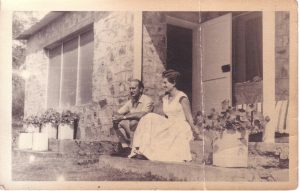Dr Christopher Charles Gawler Draper was born in Malaysia in 1921 and educated at Sherbourne and New College Oxford, graduating in 1945. As a medical student in Oxford he was involved with the trials of penicillin at the Radcliffe Infirmary as part of the war effort and then spent a year as a resident junior doctor before being posted to Japan with the ANZACs for 18 months as a medical officer.
Draper undertook a six month posting in the Middle East with the International Red Cross in 1949, during which he worked as the first medical officer at a Palestinian refugee camp in Jordan. Following his return to the UK, he took the Diploma in Public Health at the London School of Hygiene and Tropical Medicine and became a member of staff at the School and worked at LSHTM as a junior lecturer under Professor George MacDonald for 3 years. During this period he travelled to West Africa for research trips; was recruited by the East African Medical Research Service to take charge of the Pare-Taveta scheme to control malaria and worked on methods of measuring the impact of the disease on the broader health status of the people living in the region. In particular, he carried out a famous study concerning the growth of children, 1954-1960, funded by the British government. The study was written up for Draper’s doctoral thesis which he completed in 1963.

Draper returned to LSHTM in 1959 and spent a year learning the techniques needed to study viruses and was appointed deputy director of the West African Council Unit in Lagos, 1960, where he stayed for 3 years. Draper worked for the Wellcome Foundation as a medical virologist in Kent, 1964-1968 and returned to LSHTM as a senior lecturer in the Department of Tropical Hygiene, 1969. Throughout the 1970s and 1980s he carried out research projects in Brazil, Salvador, the United States, Mauritius, Sudan, Ethiopia, Uganda, Tanzania, Egypt, the Caribbean, Panama, India, the Philippines, Burma, Thailand, Greece, Zambia, Cameroon, Nepal and China. His work mainly concerned malaria as well as rabies, bilharzias (schistosomiasis), Burkitt’s lymphoma and leprosy.

Draper was a member of the WHO advisory committee on malaria and the tropical medicine research board. He travelled to make inspection visits to various countries and was a pioneer of the ELISA tests and research in sero-epidemiology. After retirement he peer reviewed books and wrote several journal articles and still travelled on behalf of the WHO.
Draper died in 2006 and his papers were kindly donated to the School in June 2007 by his daughter Alison. His contemporaries and scientists today consider Draper’s work to have been ahead of its time and his impact on current anti-malaria strategy still continues to be felt.
Draper’s collection has been catalogued and is available to view here: http://calmview.lshtm.ac.uk/CalmView/default.aspx and please contact the Archives Service for further information.





